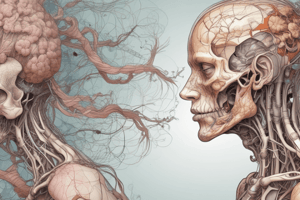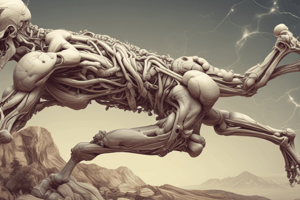Podcast
Questions and Answers
What is the primary function of the respiratory system?
What is the primary function of the respiratory system?
- To break down food into absorbable nutrients
- To produce offspring
- To regulate water and electrolyte balance
- To supply blood with oxygen and remove carbon dioxide (correct)
Which system is responsible for eliminating nitrogen-containing wastes?
Which system is responsible for eliminating nitrogen-containing wastes?
- Digestive System
- Respiratory System
- Reproductive System
- Urinary System (correct)
Which type of feedback mechanism works to negate stimuli?
Which type of feedback mechanism works to negate stimuli?
- Dynamic Feedback
- Cephalic Feedback
- Positive Feedback
- Negative Feedback (correct)
What is the term that refers to the maintenance of stability while adjusting to changes in external conditions?
What is the term that refers to the maintenance of stability while adjusting to changes in external conditions?
In anatomical terminology, what does the term 'superior' refer to?
In anatomical terminology, what does the term 'superior' refer to?
What does molecular biology primarily focus on?
What does molecular biology primarily focus on?
Which level of structural organization is directly composed of atoms?
Which level of structural organization is directly composed of atoms?
What is the primary distinction between anatomy and physiology?
What is the primary distinction between anatomy and physiology?
Which subdivision of anatomy does not require a microscope for observation?
Which subdivision of anatomy does not require a microscope for observation?
What are macromolecules primarily composed of?
What are macromolecules primarily composed of?
Which anatomical study method focuses on all structures within a specific body part?
Which anatomical study method focuses on all structures within a specific body part?
How does anatomy and physiology relate to each other?
How does anatomy and physiology relate to each other?
Which of the following is the smallest unit of all living things?
Which of the following is the smallest unit of all living things?
What is the primary focus of histology?
What is the primary focus of histology?
Which branch of physiology specifically studies the heart's function?
Which branch of physiology specifically studies the heart's function?
Which of the following systems is responsible for synthesizing vitamin D?
Which of the following systems is responsible for synthesizing vitamin D?
What does embryology focus on in developmental anatomy?
What does embryology focus on in developmental anatomy?
What does pathological anatomy primarily examine?
What does pathological anatomy primarily examine?
In which anatomical position are the arms placed?
In which anatomical position are the arms placed?
Which anatomical study visualizes internal structures using X-rays?
Which anatomical study visualizes internal structures using X-rays?
What is the focus of neurophysiology within the study of physiology?
What is the focus of neurophysiology within the study of physiology?
Which term describes a position toward the back of the body?
Which term describes a position toward the back of the body?
What does the term 'proximal' indicate in reference to body parts?
What does the term 'proximal' indicate in reference to body parts?
Which region refers to the area overlying the pelvis anteriorly?
Which region refers to the area overlying the pelvis anteriorly?
What is the term for structures located on opposite sides of the body?
What is the term for structures located on opposite sides of the body?
Which of the following terms is used to describe the front of the body?
Which of the following terms is used to describe the front of the body?
What does the term 'intermediate' refer to?
What does the term 'intermediate' refer to?
Which term specifically refers to the curve of the shoulder area?
Which term specifically refers to the curve of the shoulder area?
What area is referred to as the 'dorsal' region?
What area is referred to as the 'dorsal' region?
Which term is used to describe the lower back region?
Which term is used to describe the lower back region?
What does 'palmar' refer to in terms of body regions?
What does 'palmar' refer to in terms of body regions?
Which plane divides the body into equal left and right halves?
Which plane divides the body into equal left and right halves?
Which body cavity protects the brain?
Which body cavity protects the brain?
What separates the thoracic cavity from the rest of the ventral cavity?
What separates the thoracic cavity from the rest of the ventral cavity?
Which organ is contained within the superior abdominal cavity?
Which organ is contained within the superior abdominal cavity?
Which of the following regions contains the gallbladder?
Which of the following regions contains the gallbladder?
Which plane separates the body into anterior and posterior sections?
Which plane separates the body into anterior and posterior sections?
In which cavity would you find the reproductive organs?
In which cavity would you find the reproductive organs?
What is the primary characteristic of an oblique plane?
What is the primary characteristic of an oblique plane?
Flashcards are hidden until you start studying
Study Notes
Anatomy & Physiology
- Anatomy refers to the study of internal and external structures of the body and their physical relationship
- Physiology refers to the study of functions of those structures
- Structure determines the functions that can take place
Subdivisions of Anatomy
- Gross Anatomy:
- Regional: all structures in one part of the body (particular area of the body)
- Systemic: gross anatomy of the body studied by system (looks at just one system)
- Surface: study of the internal structure as they relate to the overlying skin.
- Microscopic Anatomy:
- Cytology: study of the cell.
- Histology: study of the tissues.
- Developmental Anatomy:
- Embryology: study of the developmental changes of the body before birth.
Subdivisions of Physiology
- Based on organ systems
- Neurophysiology: explains the workings of the nervous system
- Cardiac Physiology: studies the function of the heart
Levels of Structural Organization:
- Atoms: tiny building blocks of matter
- Molecules: such as water, sugar, and proteins, like those that make up our muscles
- Compound
- Macromolecules: lipids, carbohydrates, protein, nucleic acid
- Organelle: part of cells
- Cell: the smallest units of all living things
- Tissue: consist of groups of similar cells that have a common function
- Organ: structure composed of two or more tissue types that performs a specific function for the body
- Organ System: group of organs that work together to accomplish a common purpose
- Organism: represents the highest level of structural organization
Anatomical Position
- Standing straight
- Head and eyes facing forward
- Arms on the side slightly away from the trunk, palms facing forward
- Feet on the ground facing forward
Homeostasis
- state of balance
- maintaining stability while adjusting to changing external conditions
- dynamic process in order to survive external challenges
Positive and Negative Feedback
- Positive Feedback: intensifies stimuli (Ex. childbirth)
- Negative Feedback: negates stimuli (Ex. temperature regulation)
Language of Anatomy: Directional Terms
- Superior/Cephalic: towards the head
- Inferior/Caudal: towards the foot
- Anterior/Ventral: towards the front
- Posterior/Dorsal: towards the back
- Medial: towards the middle
- Lateral: away from the middle
- Intermediate: in between
- Proximal: close to the point of attachment
- Distal: far from the point of attachment
- Ipsilateral: structures that can be found on the same side of the body
- Contralateral: different side of the body
Body Landmarks/Regional Terms:
- Cephalic: pertains to the head
- Frontal: forehead
- Orbital: eyes
- Nasal: nose
- Buccal: cheeks
- Oral: mouth
- Mental: chin or jaw
- Occipital: back of the head
- Cervical: neck
- Thoracic: chest
- Sternal: breastbone area
- Axillary: armpit
- Pectoral: relating to, or occurring in or on, the chest
- Abdominal: abdomen/ anterior body trunk inferior to ribs
- Umbilical: navel
- Pelvic: hips/ area overlying the pelvis anteriorly
- Inguinal: groin
- Pubic: genitals
- Dorsal: back
- Scapular: shoulder blades
- Vertebral: spine
- Lumbar: lower back
- Sacral: sacrum
- Gluteal: glutes/ buttoks
- Acromial: highest point of shoulder
- Deltoid: curve of the shoulder
- Brachial: arm
- Antecubital: front portion of elbow
- Olecranial: elbow
- Antebranchial: forearm
- Carpal: wrist
- Palmar: palm
- Digital: fingers
- Coxal: hip
- Femoral: femur/thigh
- Patellar: patella/ anterior knee
- Popliteal: back of patella/knee cap
- Crural: leg
- Sural: calves
- Fibular: lateral part of leg
- Tarsal: ankle
- Calcaneal: sole of the feet (heel)
- Digital: digits of the toes
- Plantar: sole of the foot
Abdominopelvic Quadrants/Region
- Right Hypochondriac Region
- Epigastric Region
- Left Hypochondriac Region
- Right Lumbar Region
- Umbilical Region
- Left Lumbar Region
- Right Iliac Region
- Hypogastric Region
- Left Iliac Region
- Superficial organs:
- Ascending Colon
- Esophagus
- Descending Colon
- Liver
- Pancreas
- Left Kidney
- Gall Bladder
- Right & Left Adrenal Glands
- Liver
- Right Kidney
- Small Intestine
- Transverse Colon
- Spleen
- Stomach
- Spleen
- Stomach
- Transverse Colon
- Ascending Colon
- Pancreas
- Descending Colon
- Gall Bladder
- Left Kidney
- Liver
- Right & Left Kidney
- Right & Left Ureters
- Small Intestine
- Stomach
Body Planes
- Sagittal Plane: separates the body left and right
- Midsagittal Plane: equal
- Parasagittal Plane: unequal
- Oblique Plane: something not parallel
- Frontal Plane: separates the body front and back
- Transverse (or horizontal) Plane: separates the body up and down
Body Cavities and Membranes
- Dorsal Body Cavity
- Cranial Cavity: space inside the bony skull that protects the brain
- Spinal Cavity: extends from the cranial cavity to the end of the spinal cord
- Ventral Body Cavity:
- Superior Thoracic Cavity: separated from the rest of the ventral cavity by the diaphragm
- Superior Abdominal Cavity: conatins the stomach, liver, intestines, and other organs
- Inferior Pelvic Cavity: contains the reproductive organs, bladder, and rectum
Other Body Cavities
- Oral Cavity: contains the teeth and tongue
- Nasal Cavity: contains the nasal passages
- Orbital Cavities: contains the eyes
- Middle Ear Cavities: contains the middle ear bones
Studying That Suits You
Use AI to generate personalized quizzes and flashcards to suit your learning preferences.





